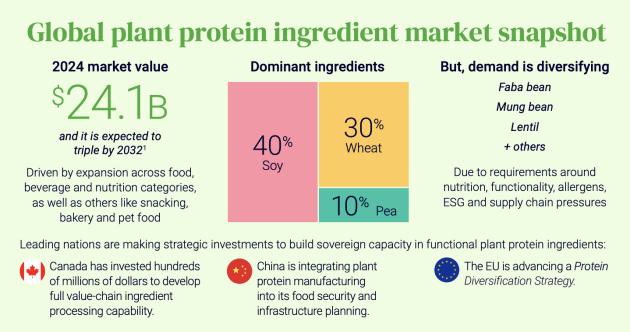Australia is at a critical crossroads in the race to capture value from the booming global plant protein industry, according to a new industry report released by Food Frontier.
While global demand for plant protein ingredients is accelerating, Australia remains largely an exporter of raw commodities rather than a manufacturer of high-value protein ingredients.
The report argues that with the right strategy, Australia could leverage its strengths in crop production, research, and manufacturing to establish itself as a premium supplier of provenance-led plant protein ingredients.

Global market growth
The global plant protein market, valued at $36.8 billion in 2024, is forecast to nearly triple by 2032. Growth is being fuelled not only by food and beverage innovation but also by categories such as nutrition, pet food, and even personal care and industrial products.
Soy, wheat and pea remain the dominant sources, but demand is diversifying into crops such as faba bean, mung and lentil due to allergen sensitivities, functionality, supply chain resilience and ESG considerations.
Governments and multinationals are responding. Canada has invested hundreds of millions into end-to-end processing capacity, China has incorporated plant protein into food security planning, and the EU has launched a Protein Diversification Strategy.
Untapped Australian potential
Australia produces around 59 million tonnes of protein-rich cereals, pulses and oilseeds each year, leading the world in lupin production and ranking as a major supplier of wheat, barley and canola.
Yet in FY23, Australia exported 40.9 million tonnes of protein-rich crops unprocessed, while importing 118,000 tonnes of plant protein ingredients. The report highlights this as a major missed opportunity to capture more value domestically and strengthen resilience.
“This disconnect points to a critical missed opportunity: a shift from bulk exports to high value processing could enable greater domestic economic return, support regional resilience and meet growing demand for quality ingredients,” the report said.
Demand signals emerging
Ingredient audits of nearly 3000 retail products across supermarkets between 2022 and 2024 showed a 12 per cent inclusion rate of plant protein ingredients, with diversification emerging beyond soy, wheat and pea into faba bean, lupin and hemp.
Broader consumer demand for high-protein, fibre-rich, allergen-sensitive and “clean label” products is supporting growth, while foodservice and healthcare sectors are investigating protein fortification for nutrition outcomes.
A sector taking shape
Six companies are now active in plant protein manufacturing in Australia, including Manildra Group, Essantis, Integra Foods, Australian Plant Proteins, Wide Open Agriculture and Hemp Harvests.
These firms are producing isolates, concentrates, flours, starches, fibres and oils for local and export markets, though capacity remains small compared with international competitors.
The report identified five key opportunities for Australia:
- Diversification to meet global demand – supplying high-quality, functional ingredients with provenance, particularly to Asia-Pacific.
- Import displacement to strengthen food security – replacing imported ingredients with domestic alternatives.
- Sustainable value-addition for agriculture – capturing more value for growers and supporting rotational cropping.
- Regional manufacturing to drive circularity – reducing freight costs, valorising co-products and boosting regional supply resilience.
- Integration with the bioeconomy – providing feedstocks for biofuels and other biomanufacturing applications.
But despite early progress, significant barriers remain:
- Sales and product development – lack of awareness and application R&D support.
- Cost and scale – high unit costs and competition from established global players.
- Investment challenges – capital constraints and cautious investors.
- Upstream supply variability – inconsistent logistics and raw commodity fluctuations.
- Regulatory hurdles – outdated rules, particularly for hemp.
The report warns that without coordinated national action, Australia risks falling behind international competitors who are already executing on integrated strategies and large-scale investment.
The full report is here.






